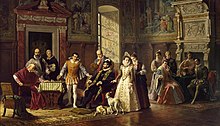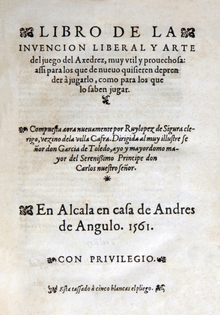| Ruy López de Segura | |
|---|---|
 Ruy López playing Leonardo di Bona in the Spanish royal court; also depicted is King Philip II of Spain. (Luigi Mussini, 1883) Ruy López playing Leonardo di Bona in the Spanish royal court; also depicted is King Philip II of Spain. (Luigi Mussini, 1883) | |
| Full name | Rodrigo López de Segura |
| Country | Spain |
| Born | c. 1530 Segura |
| Died | c. 1580 (aged c. 50) |
Rodrigo "Ruy" López de Segura (c. 1530 – c. 1580) was a Spanish chess player, author, and Catholic priest whose 1561 treatise Libro de la invención liberal y Arte del juego del Axedrez was one of the first books about modern chess in Europe. He made great contributions to chess opening theory, including in the King's Gambit and the Ruy López (or Spanish) opening that bears his name. López was also the strongest player in Spain for about 20 years.
Life
López was a native of Segura de León, a town in Extremadura, Spain. In 1559, while living in Zafra, López was called to Rome by Pope Pius IV on ecclesiastical business. During his stay in Rome, López played chess with the locals. He apparently acquitted himself well, although the only account of these games is given in a single sentence by López himself. One of those players was Il Puttino, an epithet for a young Leonardo di Bona. López also learned the term gambit from the Italian players.
In Italy López encountered Pedro Damiano's treatise on chess, Questo libro e da imparare giocare a scachi et de li partiti, but did not find much value in it. This may have inspired López to write his own book, Libro de la Invencion liberal y Arte del juego del Axedrez, which was published in 1561.
López was the strongest player in Spain for nearly twenty years; his nearest rivals were Alfonso Ceron (of Granada) and Medrano. López and Ceron played before King Philip II of Spain, impressing him enough for López to earn a benefice and a golden chain displaying a rook. López was also esteemed for his ability at blindfold chess.
Alessandro Salvio writes that López travelled to Rome again in 1572. It is more probable, however, that López visited Rome only once (in 1559) and that Salvio's chronology is incorrect.
Around the year 1574, López was still at the royal court in Spain when di Bona, then Paolo Boi, arrived on their tours of Europe. Their meetings – which also included Ceron – are sometimes considered the first international chess tournament. Boi and a much-improved di Bona defeated López and Ceron in Madrid, in the presence of Philip II. López was again able to best Ceron.
The years of López's birth and death can be estimated only very approximately; a lifespan of ca. 1530–1580 is commonly given without evidence. He was likely born before 1534, and lived until at least the 1574 contest.
Legacy
Ruy López's contribution to chess was mainly to its opening theory; Peter J. Monté has described him as the "father of opening theory". His analysis of the King's Gambit in particular went well beyond earlier writing such as Damiano's. He also was the strongest player in Spain, and possibly Italy, for about twenty years. As Andrew Soltis describes: "At that time, the best players of modern-rules chess lived in Italy and Iberia. López is believed to have easily beaten the most skilled Italians. He may deserve the title of world champion, but that title did not exist until the late nineteenth century."
López's reputation suffered from the writings of the Modenese Masters. Ponziani described López as unfruitful, unmethodical, and having made little advance on Damiano. H.J.R Murray argues, however, that the Masters' criticism of López is unfair and likely stems from his play's resemblance to Philidor's, who was their school's great rival:
Living before the great rival schools of chess which divided the players of the 18th and early 19th centuries had arisen, López yet belongs essentially to that school of chess which we are accustomed to associate with the name of Philidor. In his analysis, and especially in the games in his second book, we may trace the genesis of that theory of Pawn-play which Philidor reduced to a system two centuries later.
— H.J.R Murray
Libro de la Invencion liberal y Arte del juego del Axedrez

Ruy López's surviving treatise, which is fully titled Libro de la Invencion liberal y Arte del juego del Axedrez, por Ruy-López de Sigura, clerigo, vezino de la villago Cafra. Digirida al muy Illustre Señor Don Garcia de Toledo, ayo y mayordomo del serenissimo principe Don Carlos nuestro Señor., was published in 1561.
López divided his book into four parts ("books"). He first presents several mythological origins of the game, and discusses its benefits, rules, and strategies while interspersing a number of quotes (in Latin) from classical authors. The second part focuses on openings and is López's legacy as "the father of opening theory." Third comes a hostile appraisal of Damiano's opening analysis. López's final chapters are devoted to odds chess, where he again criticizes Damiano's approaches to these games.
In this work López presents sixty-six games, of which twenty-four were taken from Damiano's 1512 book. According to J.H. Sarartt, López's games are of a lower quality than those in Damiano's work. He admits that they might nevertheless be more instructive, since López gives a larger number of variations. Other authors have given varying opinions about the quality of López's analysis.
López only rarely presented variations that ended in checkmate. Instead he concluded lines with comments such as how black must lose his queen, or that white has a very good game.
Example games
This section uses algebraic notation to describe chess moves.Not many games can be confidently attributed to López, and those that can are incomplete. One such game was recorded by Polerio, and was played during the contests between Italians and Spaniards before King Philip II:
1.e4 e5 2.Nf3 Nc6 3.Bc4 Bc5 4.c3 Qe7 5.b4 Bb6 6.a4 a6 7.Ba3 d6 8.Qe2 Bg4 9.d3 Nf6 10.Nbd2
Among the analysis Ruy López gives in his treatise is an example of the opening that bears his name. López contends that the following line proves black should avoid the "Ruy López" by playing 2... d6 instead of 2... Nc6.
1.e4 e5 2.Nf3 Nc6 3.Bb5 Bc5 4.c3 d6 5.d4 exd4 6.cxd4 Bb4+ 7.Nc3 Bd7 8.Bf4 Nf6 9.Qd3 Bxc3+ 10.bxc3
López also gives a number of variations of the King's Gambit, such as:
1.e4 e5 2.f4 exf4 3.Nf3 Nf6 4.e5 Qe7 5.Qe2 Nh5 6.Nc3 c6 7.Ne4
Openings named for Ruy López
| a | b | c | d | e | f | g | h | ||
| 8 |  | 8 | |||||||
| 7 | 7 | ||||||||
| 6 | 6 | ||||||||
| 5 | 5 | ||||||||
| 4 | 4 | ||||||||
| 3 | 3 | ||||||||
| 2 | 2 | ||||||||
| 1 | 1 | ||||||||
| a | b | c | d | e | f | g | h | ||
The following chess openings bear López's name:
- C20 Open Game: López/Mcleod Opening,1.e4 e5 2.c3
- C23 Bishop's Opening: López Gambit, 1.e4 e5 2.Bc4 Bc5 3.Qe2 Nc6 4.c3 Nf6 5.f4
- C33 KGA: Bishop's Gambit, Ruy López Defence, 1.e4 e5 2.f4 exf4 3.Bc4 c6
- C33 KGA: Bishop's Gambit, López–Gianutio Countergambit 1.e4 e5 2.f4 exf4 3.Bc4 f5
- C60 Spanish (Ruy Lopez), 1.e4 e5 2.Nf3 Nc6 3.Bb5
- C41 Philidor: López Countergambit, 1.e4 e5 2.Nf3 d6 3.Bc4 f5
References
- ^ Monté 2014, p. 145.
- ^ Murray 2012, p. 817.
- ^ Murray 2012, p. 813.
- ^ Monté 2014, p. 128.
- Murray 2012, p. 818.
- Monté 2014, p. 146.
- ^ McGrath, Soltis & López 2020, p. xvi.
- Monté 2014, pp. 125–127.
- McGrath, Soltis & López 2020, p. 18.
- Monté 2014, p. 127.
- Sarratt 1813, p. xiii.
- Sarratt 1813, p. 57.
- Sarratt 1813, p. 40.
- Monté 2014, p. 142.
- Sarratt 1813, p. 154.
- Sarratt 1813, p. 85.
- Hudson 2011.
Bibliography
- Hooper, David; Whyld, Kenneth (1996) . "López de Segura". The Oxford Companion to Chess (2nd ed.). Oxford University Press. pp. 234–35. ISBN 0-19-280049-3.
- Hudson, Shane (January 2011). "scid.eco".
- Márquez, Andrades; Palau, Tana; Sallent, Domènec (2014). "Memòria de la restauració del Llibre CM-291: "Libro de la invencion liberal y arte del juego del axedrez..." de Ruy López de Segura". hdl:2445/61664.
- McGrath, Michael J.; Soltis, Andrew; López, Ruy (2020). The Art of the Game of Chess. Catholic University of America Press. ISBN 978-0-8132-3281-2.
- Monté, Peter J. (2014). The Classical Era of Modern Chess. Jefferson, North Carolina: McFarland & Company, Inc., Publishers. ISBN 978-0-7864-6688-7.
- Murray, H. J. R. (2012) . A History of Chess. Skyhorse. ISBN 978-1-62087-062-4.
- Sarratt, Jacob Henry (1813). The works of Damiano, Ruy-López, and Salvio on the game of chess. London.
External links
- Ruy Lopez de Segura player profile and games at Chessgames.com